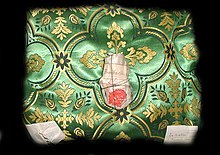ධාතු කරඬුව
මෙම ලිපිය පරිවර්තනය කළ යුතුය කරුණාකර මෙම ලිපිය සිංහල භාෂාවට පරිවර්තනය කිරීමෙන් දායකවන්න. |
ධාතු කරඬුව යනු ධාතු සඳහා බහාලුමකි. අතේ ගෙන යා හැකි ධාතු කරඬුවක් ෆෙරේටර් ලෙස හැඳින්විය හැක. එය පිහිටා ඇති දේවස්ථානයක් ෆෙරෙටරි හෝ ෆෙරෙටරි ලෙස හැඳින්වේ.


ධාතු යනු සාන්තුවරයන්ගේ චේතනාන්විත හෝ සැබෑ භෞතික දේහයන් විය හැකිය. ඒවායේ ඇටකටු, ඇඳුම් කෑලි හෝ සාන්තුවරයන් හෝ වෙනත් ආගමික පුද්ගලයින් සමඟ සම්බන්ධ වූ යම් වස්තුවක් ඇතුළත් විය හැකිය. ලබා දී ඇති ඕනෑම ධාතුවක සත්යතාව බොහෝ විට විවාදයට තුඩු දෙන කරුණකි; එම හේතුව නිසා, සමහර පල්ලිවලට ධාතු ප්රභවය පිළිබඳ ලියකියවිලි අවශ්ය වේ.
ධාතූන් බොහෝ කලක සිට බෞද්ධයන්, කිතුනුවන්, හින්දු, සහ වෙනත් බොහෝ ආගම් අදහන අයට වැදගත් වී ඇත.[1][2][3] මෙම සංස්කෘතීන් බොහෝ විට පූජනීය ස්ථාන, පල්ලි හෝ පන්සල්වල ධාතු ප්රදර්ශනය කරයි, ඇදහිලිවන්තයන් ආශීර්වාද ලබා ගැනීම සඳහා වන්දනා ගමන් කරයි.
ක්රිස්තියානි ධර්මය තුළ
සංස්කරණයඅවම වශයෙන් 4 වන සියවසේ සිට ක්රිස්තියානි පිළිවෙත්වල වැදගත් අංගයක් වූයේ ධාතු භාවිතා කිරීම, මුලින් නැගෙනහිර පල්ලිවල, බටහිරට වඩා බොහෝ කලකට පෙර සාන්තුවරයන්ගේ සිරුරු ගෙනයාම සහ බෙදීමේ පුරුද්ද අනුගමනය කරන ලදී. රෝමයේ මෙන් නොව කොන්ස්ටන්ටිනොප්ල්හි නව අගනුවර මිහිදන් කරන ලද සාන්තුවරයන් නොමැති නිසා මෙය අර්ධ වශයෙන් විය හැකිය. පෙරදිග ඕතඩොක්ස්, නැගෙනහිර ඕතඩොක්ස්, රෝමානු කතෝලික සහ සමහර ඇංග්ලිකන් පල්ලිවල ධාතූන් වහන්සේලා වන්දනාමාන කරති. කරඬු ධාතු ආරක්ෂා කිරීමටත් ප්රදර්ශනය කිරීමටත් මාර්ගයක් සපයයි. බොහෝ විට පෙට්ටිවල ස්වරූපය ගන්නා අතර, ඒවා සරල පෙන්ඩන්ට් හෝ මුදු වල සිට ඉතා විස්තීර්ණ ඔශුවරීස් දක්වා ප්රමාණයෙන් යුක්ත වේ.
Forms
සංස්කරණයThe earliest reliquaries were essentially boxes, either simply box-shaped or based on an architectural design, taking the form of a model of a church with a pitched roof. These latter are known by the French term chasse, and typical examples from the 12th to 14th century have wooden frameworks with gilt-copper plaques nailed on, decorated in champlevé enamel. Limoges was the largest production centre; NB the English usage differs from that of the French châsse, which denotes large size rather than shape.
Relics of the True Cross became very popular from the 9th century onward and were housed in magnificent gold and silver cross-shaped reliquaries decorated with enamels and precious stones. From about the end of the 10th century, reliquaries in the shape of the relics they housed also became popular; hence, for instance, the skull of Pope Alexander I was housed in a head-shaped reliquary. Similarly, the bones of saints were often housed in reliquaries that recalled the shape of the original body part, such as an arm or a foot.
Many Eastern Orthodox reliquaries housing tiny pieces of relics have circular or cylindrical slots in which small disks of wax-mastic are placed, in which the actual relic is embedded.[4]
A philatory is a transparent reliquary designed to contain and exhibit the bones and relics of saints. This style of reliquary has a viewing portal to view the relic inside. The feretrum was a medieval form of reliquary or shrine containing the sacred effigies and relics of a saint.
During the later Middle Ages, the monstrance form, primarily used for consecrated hosts, was sometimes used for reliquaries. These housed the relic in a rock crystal, or glass capsule mounted on a column above a base, enabling the relic to be displayed to the faithful. Reliquaries in the form of large pieces of metalwork jewellery also appeared around this time, housing tiny relics such as pieces of the Holy Thorn, notably the Holy Thorn Reliquary now in the British Museum.
In Buddhism
සංස්කරණයIn Buddhism, stupas are an important form of a reliquary and may be buried inside larger structures such as a stupa or chorten. Particularly in China and throughout East and Southeast Asia, these take the form of a pagoda; in Japan, this is known as a tō.
Two famous very early excavated reliquaries are the 1st-century Bimaran Casket and the Kanishka Casket of 127 AD, both believed to have contained part of the cremated remains of Gautama Buddha. Relics associated with Buddha are the most important in Buddhism, but those related to other enlightened figures like Sariputta and Moggallana are also highly revered.
In Buddhism, relics are known as cetiya; one of the most significant is the relic of the tooth of the Buddha in Sri Lanka. In Japan, Buddhist relics are known as shari (舎利, śarīra), and are often stored in a shariden (舎利殿, relic hall, reliquary). (See also: Japanese Buddhist architecture)
References
සංස්කරණය- ^ "Two Gandhāran Reliquaries". K. Walton Dobbins. East and West, 18 (1968), pp. 151–162.
- ^ The Stūpa and Vihāra of Kanishka I. K. Walton Dobbins. (1971). The Asiatic Society of Bengal Monograph Series, Vol. XVIII. Calcutta.
- ^ "Is the Kaniṣka Reliquary a work from Mathurā?" Mirella Levi d’Ancona. Art Bulletin, Vol. 31, No. 4 (Dec. 1949), pp. 321–323.
- ^ Tomov, Nikola; Dzhangozov, Januarius (Yanko). "Wax Embedding as a Method for Preservation of Body Relics Used by the Orthodox Church" (PDF). Acta Morphologica et Anthropologica. 25 (1–2): 122–125.
Further reading
සංස්කරණය- Bynum, Caroline Walker; Gerson, Paula (January 1997). "Body-Part Reliquaries and Body Parts in the Middle Ages". Gesta. 36 (1): 3–7. doi:10.2307/767274.
- Hahn, Cynthia (January 1997). "The Voices of the Saints: Speaking Reliquaries". Gesta. 36 (1): 20–31. doi:10.2307/767276.
- Weitzmann, Kurt, ed., Age of spirituality: late antique and early Christian art, third to seventh century, no. 569–575, 1979, Metropolitan Museum of Art, New York, ISBN 9780870991790